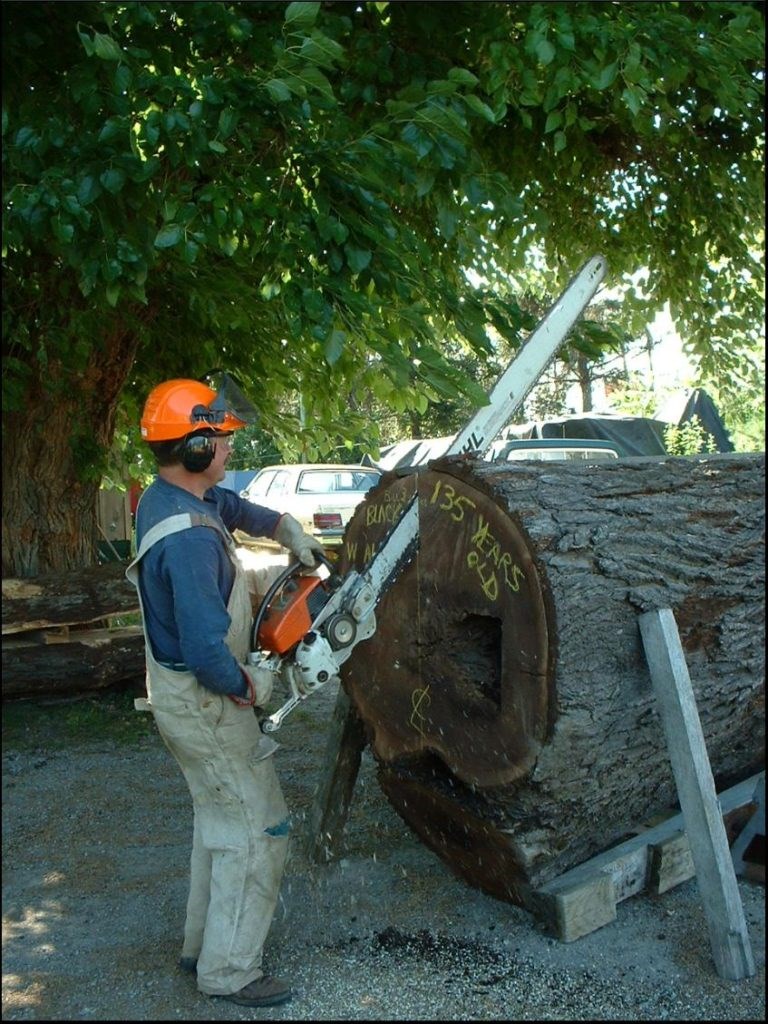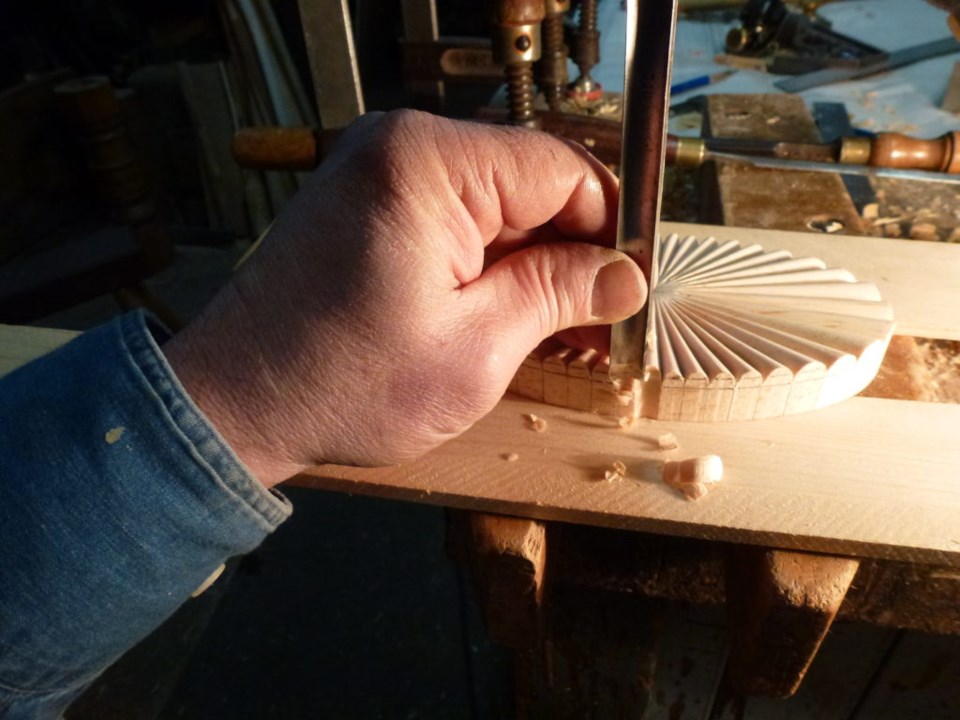
Bill German is a man at a crossroads, and looking at the direction he is about to take as the fulfillment of a goal he set for himself 40 years ago.
He and his wife Tracy now find themselves with an uncertain future, possibly out of their control, and have decided to see that as a positive sign it’s time to concentrate on what they have always wanted to do. They are making their plans knowing their Queenston Road property, tucked away behind some trees almost under the Garden City Skyway, may not be theirs for much longer, as the Ministry of Transportation makes plans for twinning the bridge, a project that could mean appropriation of the Germans’ property.
They live in a historic home they bought in 1979 from an antique dealer, for whom Bill had worked. The house was built in 1872, originally owned by a blacksmith, who also had a barn and workshop on the property, and a corral on what is now the front lawn.
Guarding the southwest side of the house is a twisted and gnarled mulberry tree, as old as the house itself, planted to shade the kitchen from the afternoon sun as dinners were prepared, says Bill.
Three generations of blacksmiths owned the property, the last one changing tires on cars as well as shoeing horses, eventually turning the site into a gas station, he says.
When he bought the property — it’s just a short distance from the Niagara Stone Road intersection and almost across the street from the former Private Eyes strip club, shuttered in October 2018, and recently sold — there was a retail space at the back of the house which had been used for antique sales. They were the kind of antiques that came from a craftsman’s bench, qualifies Bill, not a furniture factory.
For about the first six years after they purchased the property, he continued to operate the retail space, with plans to restore it and turn it into a gallery for the exquisitely crafted, detailed furniture he makes, in what he describes as Niagara Peninsula Germanic Chippendale style.
His philosophy, he says, is if he is going to make something from a tree that lived for 100 years, what he does with it matters — he wants to create something people will appreciate and use for the next 100 years.
Once established on Queenston Road, he quickly found himself taking on custom work, which included milling the wood he worked with his hands and century-old tools in a workshop heated with an antique wood stove, and that part of the business became his focus. One order after another, he carved a reputation which grew across the country for his elegant, meticulously-detailed craftsmanship, leaving him little or no time for his plans to restore their century home or for the furniture — each piece a work of art — he planned to display and sell in the retail space, which over the years became a storage space instead.
In 1993, when Si Wai Lai took charge of renovating the Prince of Wales Hotel for her brother, Jimmy Lai, she soon learned of Bill’s magical ability to turn wood into art.
The astute businesswoman arrived at his workshop one day, says Bill, wanting 65 king-sized beds for the upscale rooms she was creating for the renovated Queen Street hotel. And she wanted them in a hurry.
A deal was struck — he crafted 60 beds of maple and five of mahogany. He continued to create custom pieces for her — including desks, bar stools, lamp tables, and the majestic columns at the front of the hotel — work that kept him busy for several years.
He jokes that when he saw one of his four-poster beds in a completed room, he noticed the $900 room rate on the back of the door, and thought to himself, “This must be a month’s rent.”
One of the most important projects for the local craftsman was the work he did in Addison Hall at St. Mark’s Church, including beautiful bookshelves to store a collection of 1,500 volumes, which were brought to Niagara-on-the-Lake in 1792 by Robert Addison, the English clergyman commissioned to come to Niagara who became the first minister of St. Mark’s. Bill worked with the late local artist Campbell Scott, who designed the project.
Now, the scaffolding up on their historic house for some necessary exterior work, he and Tracy hope to make it the showcase it should be, finally acting on dreams to transform the storage space into a gallery to display the woodworking pieces he will craft.
He and Tracy have known since March 2011 their property could one day be expropriated for the twinning of the skyway, with a second bridge planned to be constructed north of the existing bridge to provide an eight-lane canal crossing, but they still want the house, whatever its future, to be the best it can be.
Bill recalls the property they now own was the site of expropriation for the current skyway — in 1959, he says, a strip of 35 feet was taken from the back section.
About three years ago, a Ministry of Transportation representative told NOTL council there were about 70 properties that would be required to allow the twinning construction to proceed, hopefully to be settled without expropriation being necessary for the project that was then anticipated to be finished by 2025. The German property was one of them, but it’s not just a few feet — it’s now required in its entirety, if the work goes ahead.
The preliminary design work and environmental assessment study were completed in 2017, but although there has been some conversation with the Ministry of Transportation about putting a price on the property, “it’s still a long way away. We’re nowhere near there yet,” says Bill. The project has not yet been budgeted, with a price tag expected to be in the hundreds of millions of dollars, and with a new and different political landscape, the money might not be available any time soon, he says.
Just two months after they first learned in 2011 about the skyway project and the impact it could have on their life and their livelihood, the couple suffered the tragic loss of their son. The fate of their property at that point took second place to their grief.
The looming possibility of expropriation, which the Germans have lived with for eight years now, Bill thinks of as “life interrupted,” he says, “a very minor setback compared to the loss of our son.”
They remain pragmatic about their future, making plans without knowing what twist it might take.
In the meantime, with no idea of what will happen or when, he remains passionate about the craft he has pursued for the last four decades, “now realizing how short life is,” he says.
They’ve looked around and made some enquiries about where they could relocate, and although they believe the expansion of the skyway is a necessary project, they’re waiting to see if it will ever become a reality, and making the most of the intervening years.
They’re also happy to see they have some new neighbours across the street, cleaning up the corner and making “a change for the better.”
They hope to stay in NOTL, says Tracy — it’s been their home for so long they can’t imagine going anywhere else — but they’re not sure they’ll be able to find a property with the right zoning and enough space for Bill, now “a young 60,” to carry on practising his skills.
Instead, they are concentrating on their dreams of opening a gallery and preparing for what they hope will be the first of Bill’s annual shows.
